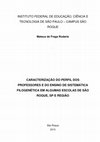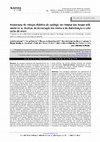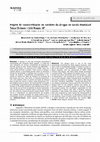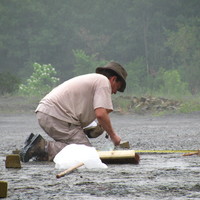Teaching Documents by Mateus De Fraga Rodarte

This work aimed to characterize the teaching of Phylogenetic Systematics in Sciences and Biology ... more This work aimed to characterize the teaching of Phylogenetic Systematics in Sciences and Biology classes at some primary education schools and high schools in São Roque, Sao Paulo State, Brazil, and other cities of the surroundings. This systematic should be taught to students because biological systematic be basic contents for teaching in many areas of biology, and the use of cladistics is the current paradgma used for this purpose, in addition to serving as a tool to cross cutting topics such as philosophy of science and evolution. Thirty-three different school teachers answered a questionnaire with questions such as their knowledge in the
area, their contacts with this area of knowledge and personal opinions about the applicability of this content with students from different scholar levels. With their answers, it was possible to trace the profile of teachers and of the teaching of Systematics, thus indicating the lack of knowledge of teachers in the area as the main barrier to the cladistics teaching, and continuing education courses as the most suitable solution to solve such problem.
Papers by Mateus De Fraga Rodarte
Retratos de uma trajetória: Pibid/UCS – 2014 a 2018, 2018
e em Biologia do Conhecimento, atuando principalmente nos seguintes temas: educação, prática educ... more e em Biologia do Conhecimento, atuando principalmente nos seguintes temas: educação, prática educativa, biologia do conhecimento e neuroeducação. Edita e publica hipertextos sobre biologia do conhecimento, artigos didáticos e de divulgação científica sobre temas da Biologia e textos sobre Ensino de Ciências e Biologia, no blog: http://www.teliga.net. Membro do corpo editorial da Revista RICA-UCS:

The zoological collections are repositories of biological material besides forming excellent sour... more The zoological collections are repositories of biological material besides forming excellent sources for studies of biological diversity. The objective of this study was to test materials and develop more efficient and inexpensive techniques to perform the assembly of a zoological teaching collection of arachnids (spiders and scorpions) and insects using the techniques of animal fouling polyester resin and preparation of vertebrates through process of leaf clearing and staining of bone with alizarin. For the process of scaling the most appropriate amounts of resin, styrene monomer, and catalyst to be used for arachnids and insects has been evaluated in addition to the most efficient material for the manufacture of molds where the biological material and the resin are mixed. Tissue-clearing techniques with 2% KOH and NaOH, and 2% alizarin staining of bone for alizarol 0.1% to 1% were also tested. It was found that for each 20 mL of resin, it is necessary to add 4 mL of styrene monomer and four drops of catalyst. The plastic was the most efficient material for the manufacture of molds, since it did not cause chemical reaction with the polyester resin, which is soft enough to facilitate removal of solid resin block after the end of the fouling process. The tissue-clearing technique with 2% NaOH allowed for greater preservation of the soft tissues compared with the one made in 2% KOH solution. It was also observed that the staining caused widespread deterioration alizarol the subject tissues, destroy animal. Staining with Alizarin 0.1% had satisfactory results, causing the intense staining of the skeleton of the specimen and showing the differential ossification through transparent muscles. The results will guide the preparation of a teaching collection that will assist directly in the practical classes of disciplines Invertebrates and Chordates II's Degree in Biological Sciences, in guidedvisits to the zoological laboratory for public school students
and as a teaching resource for that undergraduates
in biology can develop practical classes in public schools
during his supervised training.

The present study aimed to observe,
analyze, and characterize the consumption of
Xanthosoma sagit... more The present study aimed to observe,
analyze, and characterize the consumption of
Xanthosoma sagittifolium (L.) Schott (Araceae),
[known in Brazil as “taioba”] by people who live
within the central region of Sao Roque (Sao Paulo
State, Brazil) and surroundings. Such survey is
important to know whether the population uses or
not taioba’s properties. The consumption of taioba
leaves and its presence in routine food habits were
included in a specific questionnaire applied with
250 individuals from the pericentral region of the
municipality. Results have evidenced that 26,8% ofthe interviewees do eat taioba, whereas the remaining
amount does not eat it due to various reasons,
including lack of knowledge, fear of poisons
in the plant, or an ugly or filthy appearance. A total
of 101 men ranging from 12 to 83 years old,
and 149 women ranging from eight to 81 years old
were interviewed. We concluded that a small percentage
of the population in Sao Roque consume
taioba.

The dengue fever is one of the main parasitoses transmitted by Aedes aegypti mosquito; each year... more The dengue fever is one of the main parasitoses transmitted by Aedes aegypti mosquito; each year, it kills a considerable number of people in many areas of the country. The Pibid/IFSP – campus São Roque fellow students, with the partnership of EMEF Tetsu Chinone (Sao Roque, Sao Paulo State, Brazil) developed a project called " Tetsu against the dengue fever " in order to alert the school community about the symptoms, ways of transmission, and procedures to avoid the transmission of such disease, mainly considering the avoidance of increasing numbers of dengue fever cases in São Roque this year. Therefore, Pibid/IFSP – campus São Roque fellow students presented a lecture about the main points of dengue fever for the students' parents and videos, ex-pository classes and didactic games for students. During the project closing, the coordinator responsible for the activities held a lecture and, after it finished, students presented a stop-motion and posters about the subject that were produced by them during the development of this project. The importance of developing projects that can approach issues of public health with the community in places affected with parasitoses was verified.
By considering that the realization of practical classes contributes significantly to a better un... more By considering that the realization of practical classes contributes significantly to a better understanding of the theoretical content by students, the project "Experimenta PIBID" sought to develop and apply routes of practical classes for the teaching of Sciences to Junior High School students at EMEF Tetsu Chinone. Practical classes were prepared using low cost, recycled or donated materials; these practical lessons were applied considering the content planning that the supervising teacher of the project had developed. Students were involved in conducting the practical classes, with noticeable increased interest of these students for the content of Sciences. It becomes important to continuously develop practical lessons alternatively to meet different realities amongst Brazilian public schools.
Conference Presentations by Mateus De Fraga Rodarte
Para estudar a biodiversidade foram desenvolvidas diferentes sistemáticas biológicas
sendo a sist... more Para estudar a biodiversidade foram desenvolvidas diferentes sistemáticas biológicas
sendo a sistemática filogenética a atual metodologia usual. Diferentes pesquisas buscam
entender as potencialidades e dificuldades na utilização de cladogramas no ensino, entretanto
o papel que as mudanças de escala podem causar na compreensão e utilização da
cladogramas ainda é algo pouco discutido.
O objetivo do trabalho foi observar as diferentes escalas que podem ser utilizadas dentro
da classificação filogenética e suas possíveis contribuições para o estudo da diversidade
biológica. Na forma de um ensaio teórico, uma revisão bibliográfica seguida de análises
interpretativas de diagramas filogenéticos da espécie humana em diferentes escalas, foram
utilizados para evidenciar a existência de propriedades únicas a serem estudadas em cada nível
escalar.











Uploads
Teaching Documents by Mateus De Fraga Rodarte
area, their contacts with this area of knowledge and personal opinions about the applicability of this content with students from different scholar levels. With their answers, it was possible to trace the profile of teachers and of the teaching of Systematics, thus indicating the lack of knowledge of teachers in the area as the main barrier to the cladistics teaching, and continuing education courses as the most suitable solution to solve such problem.
Papers by Mateus De Fraga Rodarte
and as a teaching resource for that undergraduates
in biology can develop practical classes in public schools
during his supervised training.
analyze, and characterize the consumption of
Xanthosoma sagittifolium (L.) Schott (Araceae),
[known in Brazil as “taioba”] by people who live
within the central region of Sao Roque (Sao Paulo
State, Brazil) and surroundings. Such survey is
important to know whether the population uses or
not taioba’s properties. The consumption of taioba
leaves and its presence in routine food habits were
included in a specific questionnaire applied with
250 individuals from the pericentral region of the
municipality. Results have evidenced that 26,8% ofthe interviewees do eat taioba, whereas the remaining
amount does not eat it due to various reasons,
including lack of knowledge, fear of poisons
in the plant, or an ugly or filthy appearance. A total
of 101 men ranging from 12 to 83 years old,
and 149 women ranging from eight to 81 years old
were interviewed. We concluded that a small percentage
of the population in Sao Roque consume
taioba.
Conference Presentations by Mateus De Fraga Rodarte
sendo a sistemática filogenética a atual metodologia usual. Diferentes pesquisas buscam
entender as potencialidades e dificuldades na utilização de cladogramas no ensino, entretanto
o papel que as mudanças de escala podem causar na compreensão e utilização da
cladogramas ainda é algo pouco discutido.
O objetivo do trabalho foi observar as diferentes escalas que podem ser utilizadas dentro
da classificação filogenética e suas possíveis contribuições para o estudo da diversidade
biológica. Na forma de um ensaio teórico, uma revisão bibliográfica seguida de análises
interpretativas de diagramas filogenéticos da espécie humana em diferentes escalas, foram
utilizados para evidenciar a existência de propriedades únicas a serem estudadas em cada nível
escalar.
area, their contacts with this area of knowledge and personal opinions about the applicability of this content with students from different scholar levels. With their answers, it was possible to trace the profile of teachers and of the teaching of Systematics, thus indicating the lack of knowledge of teachers in the area as the main barrier to the cladistics teaching, and continuing education courses as the most suitable solution to solve such problem.
and as a teaching resource for that undergraduates
in biology can develop practical classes in public schools
during his supervised training.
analyze, and characterize the consumption of
Xanthosoma sagittifolium (L.) Schott (Araceae),
[known in Brazil as “taioba”] by people who live
within the central region of Sao Roque (Sao Paulo
State, Brazil) and surroundings. Such survey is
important to know whether the population uses or
not taioba’s properties. The consumption of taioba
leaves and its presence in routine food habits were
included in a specific questionnaire applied with
250 individuals from the pericentral region of the
municipality. Results have evidenced that 26,8% ofthe interviewees do eat taioba, whereas the remaining
amount does not eat it due to various reasons,
including lack of knowledge, fear of poisons
in the plant, or an ugly or filthy appearance. A total
of 101 men ranging from 12 to 83 years old,
and 149 women ranging from eight to 81 years old
were interviewed. We concluded that a small percentage
of the population in Sao Roque consume
taioba.
sendo a sistemática filogenética a atual metodologia usual. Diferentes pesquisas buscam
entender as potencialidades e dificuldades na utilização de cladogramas no ensino, entretanto
o papel que as mudanças de escala podem causar na compreensão e utilização da
cladogramas ainda é algo pouco discutido.
O objetivo do trabalho foi observar as diferentes escalas que podem ser utilizadas dentro
da classificação filogenética e suas possíveis contribuições para o estudo da diversidade
biológica. Na forma de um ensaio teórico, uma revisão bibliográfica seguida de análises
interpretativas de diagramas filogenéticos da espécie humana em diferentes escalas, foram
utilizados para evidenciar a existência de propriedades únicas a serem estudadas em cada nível
escalar.